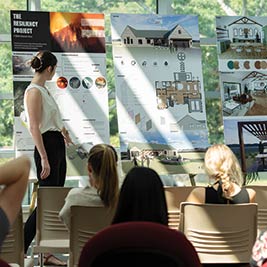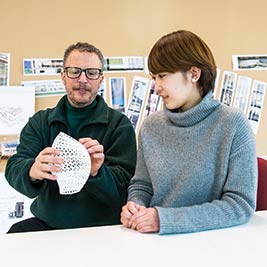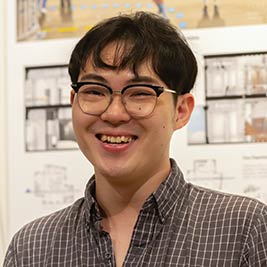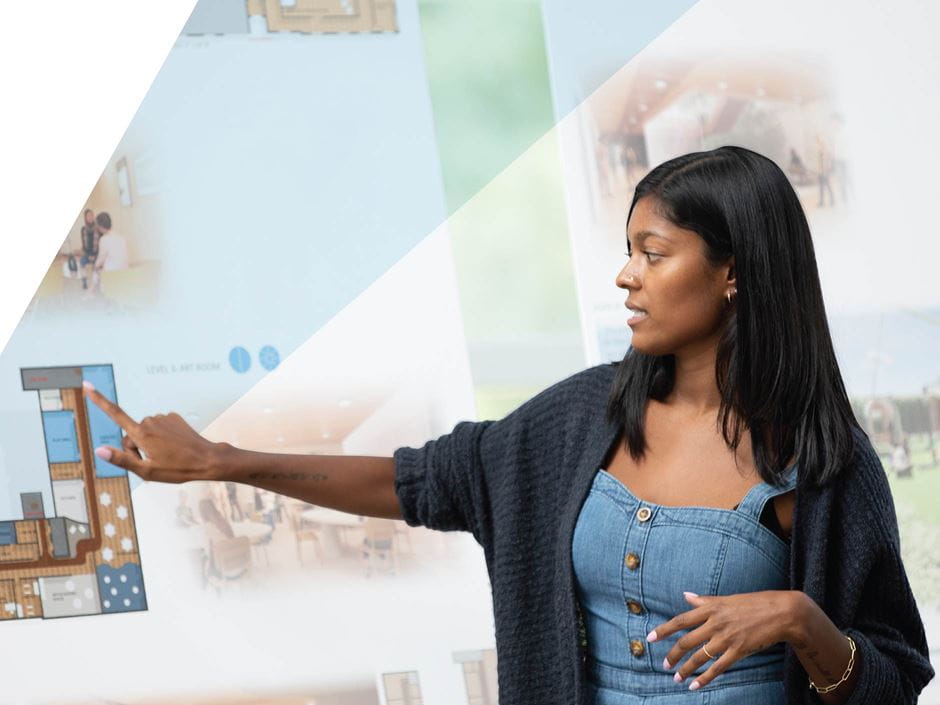In academic programming, it’s not enough to teach and train students; following industry trends is a must in ensuring students graduate with the most cutting-edge tools and experiences to succeed as professionals.
That drive to remain at the forefront of relevancy is evident everywhere in Endicott College’s Interior Design program—including its name. In 2019, Endicott changed the name of its Interior Design program to Interior Architecture.
It started with HGTV’s rise in popularity. As home improvement shows such as Love It or List It and Fixer Upper gained more and more viewers, the public overwhelmingly began to associate the title of “designer” with someone who simply beautifies spaces. But design is so much more.
 “HGTV is great, but it just highlights the end part of a big spectrum of interior design: the finishes and decoration,” explains Myoung Joo Chun, Director of Graduate Interior Architecture Programs at Endicott. “Our curriculum provides much more than that.”
“HGTV is great, but it just highlights the end part of a big spectrum of interior design: the finishes and decoration,” explains Myoung Joo Chun, Director of Graduate Interior Architecture Programs at Endicott. “Our curriculum provides much more than that.”
Endicott administration believed that changing the program’s name from Interior Design to Interior Architecture would not only strengthen students’ resumes, but also better align with program goals of teaching students hard and soft architecture skills.
“We wanted to give the right message to our candidates so they aren’t shocked by the full extent of what we design for: health, safety, and well-being of the users with innovation and aesthetic,” adds Chun. “We wanted to give clear information about what they’re getting into.”
More Than Meets the Eye
“There’s a lot of code, research, strategy, and design-thinking that really goes into each and every project to find the right solution for your client,” says Jen Servies ’07, an NCIDQ-certified senior designer at Interior Architects. Students won't just be “picking colors” for four years,” she adds.
“Over the years, I’ve definitely had to clarify my role when speaking with people because there is a very common misconception about what we do.
Servies also pointed to the popularity of HGTV as a potential barrier for up-and-coming designers. “There’s definitely a lot more that goes on behind the scenes of any of those shows—they’re working very hard to bring those designs to life. It’s not just the wave of a magic wand and your paint colors are picked and you have a pretty kitchen. There’s a lot more to it.”
Although the rigorous nature of Endicott’s Interior Architecture program might be daunting to some, it’s just one of the factors that sets the school apart from others in the area. Endicott students aren’t just sitting in classrooms and absorbing information, they’re getting hands-on experience that, ultimately, equips them for life beyond campus.
One of the standout positive influences for Jennifer Williams ’08, a licensed interior designer and registered architect, was Interior Architecture professor Andrew Brody, who was integral to student success because of his commitment to teaching new-and-now approaches. Some of the software Brody trained students on included Revit, a program used for project documentation; 3ds Max, a program used for 3D modeling and animating; and even augmented reality software.
Kayleigh Fraser ’11 M’12, a workplace sales representative at Knoll, says that Endicott’s prioritization of teaching up-to-date technology is a big reason why her degree is so valuable. “Some of the competitor schools weren’t using those programs, so that definitely gave us a leg up in the field when we were hired,” Fraser says. “Not only did we know the programs, but we were even able to teach other people how to use them.”
Internship Experience is a Two-Way Street

Keeping the curriculum current doesn’t just happen; it requires leaders such as Chun and professors such as Brody to be diligent and dedicated to bringing the best from the field into the classroom—something they’re extremely passionate about. For Brody, this means attending conferences to hear about cutting-edge technology and processes, continuing education to keep his knowledge up to snuff, and leaning on his “spies” for insider intel.
“Going to conferences is really helpful, but we also have our ‘spies,’” he says. “We have all of our students doing internships. Whenever I go to an alumni event or, particularly, when I teach Senior Internship, I think, ‘Oh, what are they doing?’ and I’ll have students do a little record or sharing session in class about what software people are using or how they’re using it in the professional environment.”
Brody illustrated that Endicott’s required internships are a mutually beneficial relationship. Firstly, the students get invaluable experience—and sometimes job offers. Endicott also gains information about what current and future students need to know to remain marketable to and equipped for the workforce. He also credits internships as a vehicle that helps guide students toward their desired career path.
Advocacy & Support Each Step of the Way
Whereas other schools simply encourage students to intern, Endicott invests resources so it can place students in diverse, rewarding internships.
“We have alumni, we have professionals who always contact me or the associate dean,” Chun says, adding that there are “a lot of different ways” the school ensures that students land with top-notch employers. Some of this comes in the form of students who are eager to pay it forward.
Fraser says that when there’s an opening at Knoll, she reaches out to her alma mater. “When we were looking for a sales assistant, Kevin Renz [Associate Dean of Architectural & Design Studies at Endicott] was the first person I emailed to see whether he knew any recent grads who might be interested,” she says. “I know how hard I had to work and how much I learned, and that’s exactly why I’m going to send an open position to Endicott. I know those are the next great designers coming, and we want them to work for us.”
The atmosphere of advocacy and giving back is something that’s prevalent at Endicott, and another reason why the school stands out from the pack. While competition is ingrained in our society and can be especially fierce in art and design programs, Endicott doesn’t pit students against each other. Instead, it promotes and facilitates camaraderie between students and faculty—something that’s ever-present in the school’s internship program, according to Renz.
“You’re not going to have the competitiveness that you have at other design schools,” Renz says, noting that Endicott students are securing internships at leading national and international design firms specializing in retail, commercial, education, health care, and other areas.
“Our students will have a resume at the completion of their degree, helping them to stand out from other students with less experience. Our students will have three internships, they’ll have letters of recommendation, and many seniors will be offered a position during their fall semester senior internship.”
A Balanced, Standout Curriculum
Make no mistake, Endicott graduates don’t land positions because of networking alone—they get these jobs because the College sets them up for success. As Chun explains, Endicott is dedicated to educating students on all aspects of design so that they can thrive in any workplace.
“As interior designers, we need to have this social and environmental responsibility because how we design, how we integrate the technology, how we pick the finishes, will affect the users greatly,” she says. “I love that part, because we can make the change in the quality of life with environment. It’s not just about aesthetic. It’s not just about health and well-being. It’s not just about technology—it’s a combination of all these. It needs to be orchestrated, and that’s why it takes time to be trained in all these different aspects.”
“We can make change in the quality of life with environment. It’s not just about aesthetic. It’s not just about health and well-being. It’s not just about technology - it’s a combination of all these.” —Myoung Joo Chun, Director of Graduate Interior Architecture Programs
Maureen Lyne ’11 M’14, an NCIDQ-certified technical designer at Gensler, was interested in Endicott because of the diverse training it offered.
“It was clear that Endicott was definitely a little more focused on the nitty-gritty aspects of design—it wasn’t just the soft skills,” she says. “Just looking at the course list, there was lighting design, there was mechanical information, there were code classes. There was some fun, frilly stuff, but I definitely noticed a difference between Endicott’s program and other programs.”
Knowing that she’d gain a broad skill set was what, in large part, propelled her to register in the program. “My experience at Endicott was great,” she says. “I definitely felt that the range of classes was very wide and covered a lot of information. It gave me a good foundation of knowledge for when I did go into the field.”
Endicott’s studio classes play a big role in training. Compared to a typical hour-long lecture class, Interior Architecture studios are six hours long. Students work together in-person and virtually to solve problems and design a space, such as a restaurant or hotel.
Servies admittedly had a “love-hate” relationship with her studio classes. “Every year, those studio classes are where you forge some really great friendships and bonds, not only with your colleagues but also with your professors,” she explains.
Impressive Outcomes
Even during the COVID-19 pandemic, the success of Endicott graduates has been staggering. According to Renz, 63% of 2020 graduates were employed in the design field and 37% enrolled in graduate school.
For Williams, her success after Endicott started with her senior internship. She worked full-time at Sasaki while still competing on the school’s field hockey team—a daunting schedule that paid off well in the end. “I was able to get a job at Sasaki without even interviewing because of my internship,” she says, “and that was even during the recession.”
Williams, who was a senior associate and senior interior project designer at Perkins & Will for more than a decade, recently accepted a position at Populous—a leading global sports architecture firm. As an associate principal and market leader there, she’ll get to merge her passion for athletics with her architecture expertise. Williams is one of many students who has thrived in Endicott’s high-energy atmosphere, and she attributed much of her success to the flexibility, support and understanding that her professors, coaches, and fellow students afforded her.
“I tell everyone how Endicott is amazing because you come out of school with that work experience,” she says. “That automatically makes you much more of a desirable hire to any company. We hired Endicott grads and interns at Perkins & Will, so it’s really come full circle.”
Discovering a Personal Style
Interior Architecture grad David Jaepil Lee M’21 recalls coming into his own during an internship in South Korea.
 Faced with hardship securing an internship in Boston due to COVID-19, David Jaepil Lee M’21 sought a position in his home country of South Korea. Not only did he land an incredible opportunity with Interior Architects (IA), but he also credits this “life-changing” internship for improving his mindset as a designer.
Faced with hardship securing an internship in Boston due to COVID-19, David Jaepil Lee M’21 sought a position in his home country of South Korea. Not only did he land an incredible opportunity with Interior Architects (IA), but he also credits this “life-changing” internship for improving his mindset as a designer.
“After the internship, all of my professors told me I changed my style—that it was better than before,” Lee said. “At first, I liked intricate designs and wanted to draw more and more elements inside busier drawings. [The internship] taught me how to delete something rather than just add something, as well as how to see my work from other points of view.”
One project Lee worked on at IA was a Samik showroom in Seoul. To hit the right notes, Lee closely collaborated with his supervisor.
“She showed me some pictures and asked me to create a similar theme,” Lee recalled. “I created the drawings and she would ask me to make changes. We kept discussing what would work better and attract audiences. In addition to learning how to kill his design darlings, Lee also gained a deep knowledge of materials beyond their aesthetic values—for instance, why certain tiles wouldn’t work in a design because of their size, color, or other factors. 
At Endicott, Lee said the varied curriculum was key. “I thought they asked us to do so many things at once, which was kind of overwhelming at first,” he said. “But now, when I look at my portfolio, I can see their plan was for us to have various design plans and the range of design was great: landscape design to preschools to health care service centers. That’s the great thing about Endicott.”
